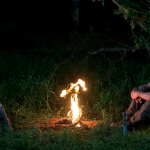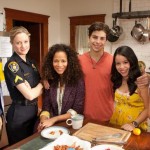Shortly before Where the Wild Things Are came to theaters, speculation began to surface that the film was too dark for young children. Many early reviews seemed to back up this claim, suggesting that the film was too dark, depressive and emotionally confusing for children. It seemed, to the average parent, that it was time to take the PG rating seriously.
Parental guidance is a good idea for this film. The reviewers may be right in some cases: there may in fact be children out there that simply don’t understand this film. They may become too frightened for the rest of the film to matter, or they may see an example to follow in any amount of bad behavior exhibited in the film. It’s possible that this could be too much for them.
But here’s the thing: the things that make this movie scary, or a possible bad influence, are simply a part of real life. And no, this isn’t the kind of “real life” we try not to expose our kids to. This is the kind of real life that our kids are exposed to on a daily basis: joy turns to humiliation in an instant, those we most love seem to turn on us for no reason, and our fantasies and/or hopes about life come crashing down around us. If anything, we are projecting onto our kids: it doesn’t freak them out so much as it does us. We have forgotten how awful it can feel to be nine years old, while they are living it every day.
Earlier in the week, I watched two Disney films with my wife: Snow White and Pinocchio. Snow White is a truly great film, pulling off a sweet, simply story on an emotional and artistic level that nothing like it had yet reached. Pinocchio, after having grown up loving the film, was a resounding disappointment – a confused, unfocused mess of a cartoon. Though the characters can be charming, it’s a wooden joke of a story that has no desire to become real.
Among these two movies, we see a fairly stark contrast between the traditional “children’s film” that Disney has made so popular and the more risky and daring Where the Wild Things Are. While both films are fantastical stories, the difference lies in the degree to which the films strive to remain truthful despite their fantasy settings.
In Disney’s films, we get all sorts of promises that cannot possibly be kept. If we sincerely dream our dreams, they will come true. True love conquers even death. Villains are easily spotted and the those who aren’t villains are genuinely good. These are the principles on which Walt Disney himself, the most famous and most influential humanist, founded the children’s film, and they remain even today.
Christians then, while still finding value in much traditional fare, should welcome the subversive, edgy children’s film with open arms; especially one like Wild Things. Max’s dreams are simple, domestic dreams: he wants his mother’s undivided attention and his sister’s friends’ approval (not to mention his absent dad’s presence). And yet, he (and the Wild Things themselves) finds that even in his escapist trip to visit the Wild Things, these dreams are unattainable and unrealistic.
Max’s villains all basically mean well, and their identities change according to the wishes of Max himself, making it clear that Max could actually rid his world of villains if he only wanted less. Those villains turn into heroes in the course of the film, though they often are powerless to save him from much of life’s little humiliations: “I would have done something,” says Max’s mother when he complains that his sister did nothing to stop her friends from terrorizing him. It is perhaps the most useless and heartwarming sentiment in the entire film. For Max, those words are enough, because they have to be.
I have nothing against escapist fantasy, to a point. There is only so much escapism one should embrace, however. The Disney brand of escapism is far more than merely imagining ourselves in a different time and place. It’s an escapism that denies foundational truths about the world – it’s a head in the sand escapism that does no one any long term good.
Where the Wild Things Are is only dark because it’s truthful about life, though it’s also hopeful. Max runs back to his family because it’s his home, not because they are perfect, or because they fulfill his wildest dreams. You never get the sense that Max lives happily ever after in his home, but you do get the sense that his family will do their best to love him and that he will do the same for them. In this broken world, that’s the best we can ask for.











